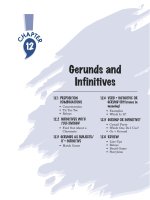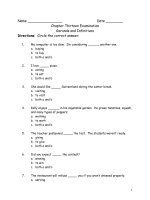Gerunds and infinitives
Bạn đang xem bản rút gọn của tài liệu. Xem và tải ngay bản đầy đủ của tài liệu tại đây (8.08 KB, 1 trang )
Gerunds and infinitives
Both gerunds and infinitives are non-finite verb forms. That means their form does not change with a change in
the subject or tense of the verb. A gerund is an –ing form that does the work of a noun. Examples are: cooking,
singing, working, sleeping etc. Gerunds are often confused with present participles because they both look
alike. However, they have different functions. Present participles function like adjectives. They are also used to
form continuous verb forms.
Infinitives usually take the marking to. An infinitive can perform the same functions as a gerund. And in most
cases, they are interchangeable.
In the following sentences, replace the gerund by an infinitive and an infinitive by a gerund.
1. To find fault with others is easy.
2. To laugh is better than to frown.
3. He likes to collect old coins and does not like to give them away.
4. To fly kites is a good sport but to bet on them is bad.
5. He likes to read and write.
6. She likes dancing and singing.
7. Our aim is passing the examination.
Answers
1. Finding fault with others is easy.
2. Laughing is better than frowning.
3. He likes collecting old coins and does not like giving them away.
4. Flying kites is a good sport but betting on them is bad.
5. He likes reading and writing.
6. He likes to sing and dance.
7. Our aim is to pass the examination.
Stay on top of your writing! Download our grammar guide from www.englishgrammar.org to stay up-to-date.
Powered by TCPDF (www.tcpdf.org)









